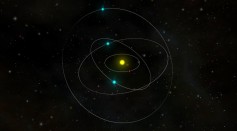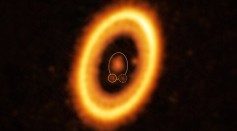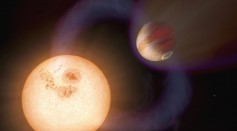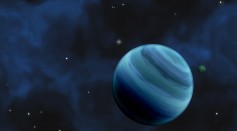Exoplanets

Potentially Habitable Exoplanet Discovered Just 40 Light Years Away; Rare Exo-Venus World Possesses Earth-Like Temperature

NASA Finds Six 'Sub-Neptune' Exoplanets in an Extraordinary Celestial Symphony Around Their Star

Bouncing Comets Deliver Molecular Building Blocks for Life on Earth, Could Do the Same to Exoplanets

NASA's Kepler Telescope Data Unveils a Planetary System With Seven Hot, Large Exoplanets

Rare Image Reveals Exoplanets Colliding 1,800 Light-Years Away, Offering Insights into Infrared Surges and Stellar Dimming

Nearly 50% of Rocky Exoplanets Revealed as 'Burning Worlds' with Lava Oceans: Study Explores Their Impact on Super-Earths

Trojan Planets Co-Existing in the Same Orbit Spotted After Being Hypothesized for 20 Years
![Exoplanets With Frozen Surfaces May Have Oceans Beneath Their Icy Shells to Host Extraterrestrial Life [Study]](https://1721181113.rsc.cdn77.org/data/images/full/47616/exoplanets-with-frozen-surfaces-may-have-oceans-beneath-their-icy-shells-to-host-extraterrestrial-life-study.jpeg?w=237&h=131)
Exoplanets With Frozen Surfaces May Have Oceans Beneath Their Icy Shells To Host Extraterrestrial Life [Study]

Scorching Hot Exoplanet Contains Unusual Amount of Nickel, Could Have Swallowed a Smaller Neighboring Planet

Hot Jupiters May Not Always Be Alone: New Research Challenges Isolation Assumption, Unveils Surprising Exoplanet Companions

Tidal Extremes From Dwarf Stars Could Sterilize Two-Thirds of Planets But Hundreds of Millions May Still Harbor Life While in the Habitable Zone

James Webb Space Telescope Takes Its First Up-Close Look at the Mysterious Atmosphere of a Mini-Neptune Exoplanet

Planets Orbiting Metal-Poor Stars More Likely To Host Life as They Are More Protected From Harmful UV Radiation

First Exoplanet Discovered Through Direct Imaging, Precision Astrometry Using Subaru Telescope
Most Popular

How Technology Is Changing the Real Estate Industry?

Study Reveals High Turnover in Scientific Research Careers: What This Means for Future Scientists

Nikolay Karpenko Biography, Photo, Career, Accomplishments

China’s Tiangong Space Station to Expand Its Capabilities With New Modules






